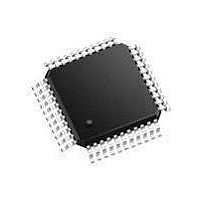TEA5762HB NXP Semiconductors, TEA5762HB Datasheet - Page 8

TEA5762HB
Manufacturer Part Number
TEA5762HB
Description
Tuners SELF TUNED RADIO
Manufacturer
NXP Semiconductors
Datasheet
1.TEA5762HV1557.pdf
(33 pages)
Specifications of TEA5762HB
Mounting Style
SMD/SMT
Package / Case
SOT-307
Lead Free Status / RoHS Status
Lead free / RoHS Compliant
Other names
TEA5762H/V1,557
Philips Semiconductors
FUNCTIONAL DESCRIPTION
The TEA5762 is an integrated radio circuit with
AM-receiver and FM-IF part with demodulator and stereo
decoder. The circuit includes digital tuning and control
functions.
The radio
The AM circuit incorporates a double balanced mixer, a
one-pin low-voltage oscillator (up to 30 MHz) and is
designed for distributed selectivity.
The AM input is designed to be connected to the top of a
tuned circuit. AGC controls the IF amplification and for
large signals it lowers the input impedance of the AM
front-end.
The first AM selectivity can be an IF-Tank (IFT) as well as
an IFT combined with a ceramic filter; the second one is an
IFT.
For FM operation an external FM front-end is necessary.
This is switched on and off by the FM-ON/OFF signal
which is generated in the bus system.
The AFC circuit in the TEA5762 provides a tuning voltage
to drive the VCO of the external FM front-end.
The frequency of the external VCO is counted in the Self
Tuned Radio (STR) tuning system.
The FM-IF circuit is designed for distributed IF ceramic
filters. The FM quadratic detector uses a ceramic
resonator.
The PLL stereo decoder incorporates a signal dependent
stereo-blend circuit and a soft-mute circuit.
Tuning
The tuning-concept of Self Tuned Radio (STR) is based on
FUZZY LOGIC: it mimics hand tuning (hand tuning is a
combination of coarse and fine tuning to the qualitatively
best frequency position). As a consequence the tuning
system is very fast.
The tuning algorithm, which is controlled by the sequential
circuit (see Fig.1), is completely integrated; so there are
only a few external components needed.
The bus and the microcontroller can be kept very simple.
The bus only consists of three wires (BUS-CLOCK, DATA
and WRITE-ENABLE). The microcontroller must basically
give two instructions:
1999 Aug 04
Preset operation
Search operation.
Self Tuned Radio (STR)
7
P
In preset mode, the microcontroller has to load information
such as frequency band, frequency and mono/stereo. This
information has to be sent via the bus to the STR.
The internal algorithm controls the tuning sequence as
follows:
1. The information is loaded into a shift register, a
2. The Automatic Frequency Control (AFC) is switched
3. The counter starts counting the VCO frequency and
4. The AFC is then switched on and the counter is
5. The real frequency is more precisely tuned to the
After the AFC has tuned the real frequency to the desired
frequency an in-lock signal can be generated. In order to
get a reliable in-lock signal, there are two parameters
measured: the field strength and the S-curve. The field
strength indicates the strength of the station and by
looking at the S-curve the system can distinguish false
in-locks from real in-locks (false in-locks occur on the
wrong slope of the S-curve).
In the FM mode the tuning voltage controls the VCO of the
external FM front-end and the frequency of the VCO is
counted in the TEA5762.
In the event of fading or pulling the in-lock signal becomes
logic 0 and the synthesizer will be switched-on again and
the algorithm will be repeated.
S
During a search operation, the only action the
microcontroller has to take is: sending the desired band
plus the direction and the search sensitivity level to the
STR. The search operation is performed by the charge
pump until an in-lock signal is generated (combination of
measuring the field strength and the S-curve). The AFC
then fine tunes to the station. The frequency belonging to
the found station will be counted by the counter and written
into the last-station memory and the shift register of the
counter. At this time the frequency is available in the shift
register and can be read by the microcontroller. The
microcontroller decides whether the frequency is within the
desired frequency band. If so, this frequency can be stored
under a preset and if not, a new search action should be
started.
RESET OPERATION
EARCH OPERATION
last-station memory and the counter.
off.
the tuning voltage is varied until the desired frequency
roughly equals the real frequency.
switched off.
desired frequency.
Product specification
TEA5762















